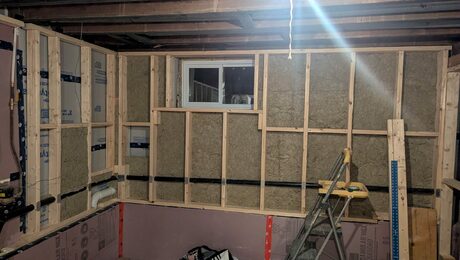*
There have been a number of discussion about different modes and types of heating equipment which have all gotten down to sizing. Different rules of thumb, manuals and computer programs have been used to come up with a number.
However, there is one area that I have not seen mentioned. That is the need to oversize the equipment for two reasons. One worse than average conditions and the other the time needed to bring the house back to setpoint after the units have been off.
My power was off for 25 hours due to an ice storm and I have also notice this when I have been gone for several days and set the thermostate back to 55. Both of my units are oversized. But the first floor unit is drastically oversized and will bring the temps backup in about 30-45 minutes.
I am in Kansas City area the design condtitions are witner dry bulb of 6 degress (97.5%) and heating degree days of 5393. But about 10 years ago we had 10 days of -15 to -20.
Now that downstairs unit will only run about 35% even at 0 degrees. My question is what kind of rules are there about how much oversizing should be used.


















Replies
*
I hope no one is using a average temperature as a design temperature. I never do. I think all the regular posters here understand the difference. Somewhat like dam design (hundred-year flood criteria), how conservative should you be? 97.5% of the time seems like not enough for me. That would eliminate all the 3 days spells of -40F that happen here once every year or two. Do you want your heating system to keep up with -40 for a few days? If the 97% design number would otherwise be -20F? Darn tootin!
I like the worst case number of the last decade or two, if available. That also covers warm-up, if needed. Or a big orgy when everyone is naked and needs a little warmer house. And how often do you need warm-up during an orgy on the coldest day of the decade?
For some engineering designs, I hang a safety factor onto a worst-case-in-the-last-decade number to arrive an aproximation of a hundred-year low. But for a house, you can always put on a sweater, plug in an electric heater or do a lot of baking that day.
Kansas City: I would have guessed, off the top of my head, a -10F design temp. That would have left you a bit cool ten years ago, but in no danger. And since heaters don't come in a infinite number of sizes, you always round up a bit (sometimes a fair bit) to the nearest size that exceeds your needs.
What do others do? -David
*Bill, Dave,I use fairly conservative values when running loads. The design critera I use for heating here in Northern Illinois is an 85 degF temperature difference (-15 to 70). The 99.6% low temp here is -10 degF. I add 20% to the U values to account for variations in construction and the like, add 10% for rooms that have north or west exposures, and then wherever the numbers end up, pick a unit that will meet this "minimum".The 99.6% design temp for KC is -1 degF, so I would design for -10.If the system is to be steam or hot water, I also account for "pickup" and piping losses by adding another 15%, unless physical layout dictates more. For forced air, no pickup is necessary.
*David, TimThanks. -10 makes a lot more sense. I got the 6 degrees out of the KC code. I see what people mean by codes being MINIMUM'S. It is enough to keep you from freezing to death, but not comfortable.
*hey, everyone. what would your approaches lead to in terms of btuh/sqft? in socal, i use 10K/500 sqft.brian
*Brian: It would all depend on house construction and design temperature. My own house does fine at -40F on 4K/500 sqft.10K(net)/500 sqft should keep a house of average construction warm to an outside temp of 0F. A bit higher than 0F if you want a margin of safety for shoddy construction, warm-up, leaving a window open, etc. If that 10K is a gross rating (about 8K, net), then it makes more sense for Low-Cal - that would cover you a bit below 20F. -David
*Brian, Rules of Thumb are useful in my business only for rough cost estimating. When it comes time to size and purchase equipment, I do calculations. No building, lot or occupancy that I've had experience with is ever exactly like any other. But the practice of doing cooling or heating by general estimates is very common and keeps me gainfully employed solving the problems glossed over by others.
*Bill,Seems like I remember seeing some specific oversizing recommendations in ASHRAE Fundamentals.David,Last dam work I did required design for Probable Maximum Precipitation event, which is roughly equivalent to a 10,000 year return period. 100-yr flood criteria is more like what you'd see for bridge design.